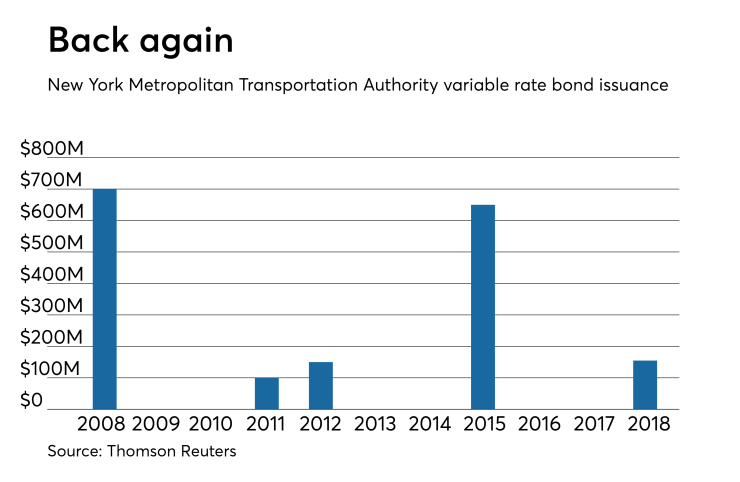
Retail investors lined up to get more New York City Transitional Finance Authority bonds while the New York Metropolitan Transportation Authority remarketed a 2015 deal.
Primary market
On Wednesday, Loop Capital Markets held the second day of retail orders on the NYC TFA’s $902.47 million of tax-exempt future tax secured subordinate fixed-rate bonds ahead of the institutional pricing on Thursday.
On Tuesday, the deal was warmly received as buyers snapped up the bonds, prompting the underwriter to curtail retail orders in the 2023, 2028 and 2029 maturities.
Additionally, the TFA is set to sell $500 million of taxable bonds in two competitive sales on Thursday. The financial advisors are Public Resources Advisory Group and Acacia Financial Group. Bond counsel are Norton Rose and Bryant Rabbino.
The deals are rated Aa1 by Moody’s Investors Service and AAA by S&P Global Ratings and Fitch Ratings.
Bank of America Merrill Lynch priced as a remarketing the N.Y. MTA’s $154.85 million of Series 2015E-3 transportation revenue variable-rate bonds.
The deal is rated Aa1 by Moody’s and AA-plus by S&P and Fitch and carries short-term ratings of VMIG1 from Moody’s, A-1 from S&P and F1-plus from Fitch.
Since 2008, the MTA has issued roughly $1.76 billion of variable rate bond debt, with the most issuance occurring in 2008 when it sold $701 million. It has been three years since it last sold variable rate debt and before that, it issued VRBDs in 2008, 2011 and 2012.

Wells Fargo Securities is expected to price the University of Chicago’s $400 million of Series 2018C taxable fixed-rate bonds.
The corporate CUSIP deal is rated Aa2 by Moody’s, AA-minus by S&P and AA-plus by Fitch.
Wednesday's bond sales
New York:
Bond Buyer 30-day visible supply at $9.17B
The Bond Buyer's 30-day visible supply calendar increased $263.3 million to $9.17 billion for Wednesday. The total is comprised of $4.46 billion of competitive sales and $4.71 billion of negotiated deals.
Secondary market
Municipal bonds were mostly weaker on Wednesday, according to a midday read of the MBIS benchmark scale. Benchmark muni yields rose less than one basis point in the two- to five-year, nine- to 13-year and 18- to 30-year maturities, fell less than a basis point in the one-year, seven-year and 15-year maturities and remained unchanged in the six-year, eight-year, 14-year and 16- and 17-year maturities.
High-grade munis were mostly weaker, with yields calculated on MBIS' AAA scale rising less than one basis point in one- to five-year and eight- to 30-year maturities and falling less than a basis point in the six- and seven-year maturities.
Municipals were weaker on Municipal Market Data’s AAA benchmark scale, which showed the yield on the 10-year muni general obligation rising as much as one basis point while the yield on 30-year muni maturity increased as much as two basis points.
Treasury bonds were mixed as stock prices traded slightly lower.
On Tuesday, the 10-year muni-to-Treasury ratio was calculated at 84.7% while the 30-year muni-to-Treasury ratio stood at 98.7%, according to MMD. The muni-to-Treasury ratio compares the yield of tax-exempt municipal bonds with the yield of taxable U.S. Treasury with comparable maturities. If the muni/Treasury ratio is above 100%, munis are yielding more than Treasury; if it is below 100%, munis are yielding less.
Previous session's activity
The Municipal Securities Rulemaking Board reported 38,151 trades on Tuesday on volume of $10.93 billion.
California, Texas and New York were the municipalities with the most trades, with Golden State taking 15.403% of the market, the Lone Star State taking 12.439% and the Empire State taking 8.666%.
Trend of positive rating actions continues
Rating upgrades from three agencies — Moody’s, S&P and Fitch — continued to outpace downgrades in the first half of 2018, Alan Schankel, managing director at Janney, wrote in a report released in Tuesday.
“On an annual basis, ups have surpassed downs every year since 2015, although there have been quarters with more downgrades for individual rating agencies,” he said. “Although this data can be useful in analyzing longer term trends, we caution that rating actions can be triggered by methodology or criteria changes, with the resulting rating changes often having little to do with underlying credit.”
For example, he noted, in the second quarter of this year, S&P bumped the ratings of 324 issuers while lowering 204 — but if changes due to criteria are eliminated from consideration, the numbers are 186 rating improvements and 177 of deteriorating credits.
“Rating agencies took some much deserved heat following the 2008 financial crisis, which in the municipal world was manifested by the seemingly overnight credit deterioration of all AAA rated municipal bond insurers," Schankel said. "Not surprisingly, the drop in the use of bond insurance elevated the importance of traditional ratings, particularly for individual investors who typically lack the professional analytic capabilities and resources of institutional investors such as mutual funds and banks.”
Data appearing in this article from Municipal Bond Information Services, including the MBIS municipal bond index, is available on The Bond Buyer Data Workstation.





